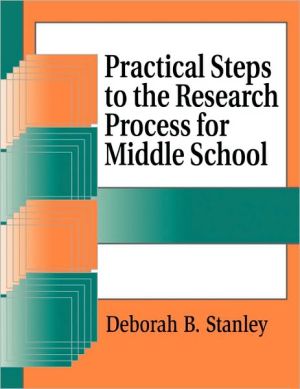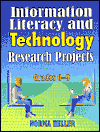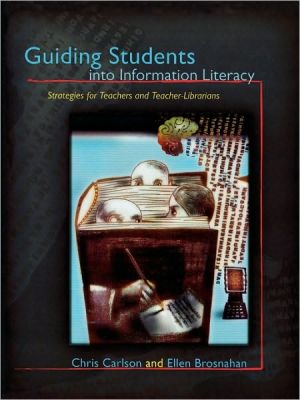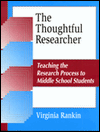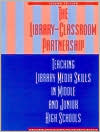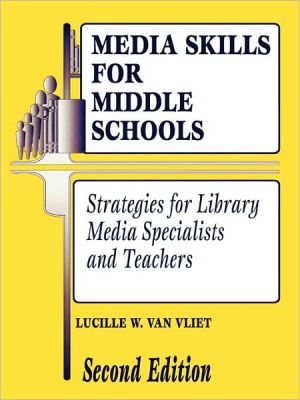Practical Steps to the Research Process for Middle School
Stanley applies the same user-friendly format that made her popular guide to teaching the six steps of the research process to high school students such a success. In this new volume geared toward middle school students, field-tested lessons, anecdotes, reproducible charts and templates, and research ideas all work together to transform the research process into bite-size steps that are both adaptable to various teaching styles and not overwhelming for students. By applying Stanley's methods...
Search in google:
Stanley applies the same user-friendly format that made her popular guide to teaching the six steps of the research process to high school students such a success. In this new volume geared toward middle school students, field-tested lessons, anecdotes, reproducible charts and templates, and research ideas all work together to transform the research process into bite-size steps that are both adaptable to various teaching styles and not overwhelming for students. By applying Stanley's methods you'll be pursuing education reforms including integrating technology, improving information literacy, teaching critical thinking, modeling collaborative instruction, and adapting research for second language learners and learning disabled students. School Library Journal This outstanding resource is designed to help a busy library media teacher present research as meaningful, "doable," and, also, challenging. The process is broken down into a four-day program of scripted lessons that emphasize strategies Stanley has tested and found to work well. The fundamental principle is collaboration between the LMT and classroom teacher to reach the goal of information literacy. The key word in the entire approach is practical. The author assumes that the LMT is familiar with research theories and is ready to plunge into the process of teaching research. The book is divided into four general sections: planning and preparation, the research process, application and accountability, and enrichment and extension. The margins contain icons that represent major trends in educational reform, such as information literacy, ELL/special modifications, problem solving, lifelong skills, etc. "Instructor Information" sections contain lists, charts, and templates, such as, "Examples of MLA Citations and Research Checklist." Permission is given to duplicate the activity sheets for classroom use. The model lessons are for research on Renaissance artists, but could easily be adapted to any subject. The book concludes with a section on connections that offers ties to standards and information literacy, based on models found in Information Power: Building Partnerships for Learning (ALA, 1998). While designed for middle school students, both elementary and high school LMTs would find this a very effective volume.-Elizabeth Stumpf, Clearfield Middle School, PA Copyright 2001 Cahners Business Information.
FiguresxiAcknowledgmentsxiiiIntroductionxvSection 1Planning and Preparation1Chapter 1What Is the Research Process?3Another Theory?5Do You See the Connections?9How Do You Eat an Elephant?10Time10Money10Training10You11The Missing Link13What It Is14What It Is Not14The Total Package14Chapter 2Collaborative Planning17Making Time for Collaborative Planning19The Microwave Oven Syndrome19Billboard Yourself20Sell Yourself20Support Teaching Styles20Adjust20The Role of the LMC Master Calendar21Color Coding21Aligning the Calendars22Signing Up22Posting the Directions24Pencils Only24Let's Do Lunch24Integrated Collaboration30Purposeful Planning30Chapter 3Lesson Preparations33Research Instruction35How Many Lessons?35Preparing the Setting37Locating Sources39Preparing Equipment/Technology41Preparing for the Unit and Lessons42Student Handouts44Section 2The Research Process51Chapter 4Developing a Topic: Lesson 1, Part 153Chapter Concepts55Where Do Topics Come From?55What Makes a Topic Good?55Does the Topic Match the Student?55What Is the Role of the Instructor in Matching Topics to Students?55Instructor Information56Finding Topics56Matching the Topic with the Student56The Instructor's Role in Topic Selection58Empowering Topic Independence60Preparing for the First Day's Lesson60Student Lesson62Getting Started62Making Meaning63Making Sense out of Topic Searching65Student Activity66Accountability68Chapter 5Developing Subtopics: Lesson 1, Part 269Chapter Concepts71Why Subtopics Are Essential71What Do You Want to Know?71Developing Subtopics71Matching Subtopics to Student Needs71Instructor Information71Why Subtopics Are Essential71What Do You Want to Know?72Developing Subtopics72Matching Subtopics to Student Needs73The Research Checklist74Instructional Strategies75Extension Lesson for Advanced Students78Due Dates78Looking Ahead at Accountability79Student Lesson79Why Subtopics Are Essential79What Do You Want to Know?80Developing Subtopics80Using Subtopics to Evaluate Information83Matching Subtopics to Students83Accountability87Chapter 6Looking at Sources: Lesson 289Chapter Concepts91Copyright and Citations91Formats and Sources91Source Requirements91Instructor Information91Copyright91Citations92Formats and Sources93Student Lesson96What Is Copyright?96Formats and Sources98Source Requirements99Accountability101Student Activity: MLA-Style Citations101General Directions101Print Encyclopedias102CD-ROM Encyclopedias108Internet Web Sites109Accountability110Extension Lessons111Simple and Annotated Citations111Learning MLA Style114Notes115Chapter 7Reading, Thinking, Selecting: Lesson 3, Part 1119Chapter Concepts121Promoting Literacy and Information Literacy121Students Must Read to Access and Comprehend Information121Students Must Think About Reading to Evaluate Information121Students Must Select Important Ideas and Keywords to Use Information121Instructor Information121Reading121Thinking123Selecting124Instructional Strategies125Adaptations for Special and Advanced Students126Student Lesson127Transitional Re-teaching127Reading128Thinking130Selecting130Chapter 8Notetaking: Lesson 3, Part 2133Chapter Concepts135The Key to Information Ownership135The Key to Literacy and Learning135Teaching Notetaking Strategies135Instructor Information135The Key to Information Ownership135The Key to Literacy and Learning136Teaching Notetaking Strategies137Setting Reasonable Expectations142The Advantage of Good Notes143Chapter 8Notetaking: Lesson 3, Part 2 (cont.)Instructional Strategies144Adaptations for Special Students144Beyond Note Cards149Student Lesson: Notetaking Strategies151The Key to Information Ownership151Preparing Note Cards153Citing Sources on Note Cards156Notes Should Look Like Notes157The Advantage of Good Notes164Accountability165Extension Lesson for Advanced Students166Citing Sources in Notes166Chapter 9Sorting and Numbering Notes: Lesson 3, Part 3169Chapter Concepts171The Importance of Sorting Notes171Reading Notes171Thinking About and Sorting Notes171Numbering Notes171Instructor Information171The Importance of Sorting Notes171Reading Notes172Thinking About and Sorting Notes172Numbering Notes173Student Lesson/Activity173The Importance of Sorting Notes173Reading Your Notes177Thinking About and Sorting Your Notes177Numbering Your Notes179Section 3Application and Accountability185Chapter 10Hands-on Research: Locational Directions187Instructor Information189Balance Instruction with Work Time189Dewey/Boolean Handouts189Student Lesson: Locational Directions191Print Sources: Using Dewey191Electronic Sources: Using Boolean Logic193Chapter 11Writing the Rough Draft: Optional Lesson195Making Time197Process Writing197Getting Started198Writing the Introduction199Prewriting199Composing200Chapter 12Tracking and Evaluation203Student Accountability204The Importance of Tracking204Prerequisites for Effective Tracking204The Role of the LMT in Student Tracking208Unit Accountability210Section 4Enrichment and Extension213Chapter 13Technology and the Creative Final Project215Beyond Writing217Technology Enriches Writing218Exciting Writing!222Chapter 14Connections223Ties to Standards, Literacy, and Information Literacy225Content-Area Standards Related to Research225Quintessential Literacy226Information Literacy Standards Affect Student Learning227Information Literacy Standards for Student Learning227Category IInformation Literacy227Category IIIndependent Learning228Category IIISocial Responsibility229Magic Bullet231Sources233References235Index237
\ School Library JournalThis outstanding resource is designed to help a busy library media teacher present research as meaningful, "doable," and, also, challenging. The process is broken down into a four-day program of scripted lessons that emphasize strategies Stanley has tested and found to work well. The fundamental principle is collaboration between the LMT and classroom teacher to reach the goal of information literacy. The key word in the entire approach is practical. The author assumes that the LMT is familiar with research theories and is ready to plunge into the process of teaching research. The book is divided into four general sections: planning and preparation, the research process, application and accountability, and enrichment and extension. The margins contain icons that represent major trends in educational reform, such as information literacy, ELL/special modifications, problem solving, lifelong skills, etc. "Instructor Information" sections contain lists, charts, and templates, such as, "Examples of MLA Citations and Research Checklist." Permission is given to duplicate the activity sheets for classroom use. The model lessons are for research on Renaissance artists, but could easily be adapted to any subject. The book concludes with a section on connections that offers ties to standards and information literacy, based on models found in Information Power: Building Partnerships for Learning (ALA, 1998). While designed for middle school students, both elementary and high school LMTs would find this a very effective volume.-Elizabeth Stumpf, Clearfield Middle School, PA Copyright 2001 Cahners Business Information.\ \ \ \ \ BooknewsOffers hands-on lessons and techniques to advance information literacy among middle school students. Shows educators how to plan for teaching research, then details every step of the research process, from finding and developing topics to creating and presenting the final research project. Pays special attention to note-taking techniques and offers research lessons along with procedures for teaching Boolean logic, tracking student progress, and tying research to standards. Includes reproducible student handouts. Stanley is a library media teacher in the Riverside Unified School District of California. Annotation c. Book News, Inc., Portland, OR (booknews.com)\ \
